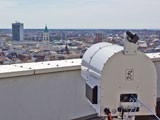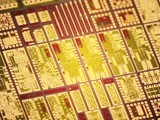New wireless world record
Researchers have achieved wireless rates of 40 Gbps at 240 GHz, a feat that promises to seamlessly span wireless and optical technologies.
Digital, mobile and networked - the changing usage habits of modern society require ever faster transmission of increasing volumes of data. Compared to the European standard, Germany lags behind in the expansion of fibre-optic networks, according to statistics from the FTTH Council Europe. Deploying new fibre-optic cables is expensive and difficult when there are natural or urban obstacles such as rivers or traffic junctions. Broadband radio links can help to overcome such critical areas, thereby facilitating the expansion of network infrastructures. In rural areas they can be a cost-effective and flexible alternative to ‘fibre to the home’.
In a feat that might help bridge the broadband gap, German researchers have set a new world record in wireless data transmission. For the first time, fully integrated electronic transmitters and receivers have been developed for a frequency of 240 GHz, which enables transmission at data rates of up to 40 Gbps. This is the equivalent of transmitting a complete DVD in less than a second, or the equivalent capacity of 2400 DSL16000 internet connections. Distances of over one kilometre have already been covered by using a long-range demonstrator, which the Karlsruhe Institute of Technology set up between two skyscrapers as part of the project “Millilink”.

“We have managed to develop a radio link based on active electronic circuits, which enables similarly high data rates as in fibre-optic systems, therefore allowing seamless integration of the radio link,” said Professor Ingmar Kallfass, who coordinated the project at Fraunhofer IAF within the scope of a shared professorship between IAF and KIT. Since early 2013, Kallfass has been with the University of Stuttgart, where he continues to lead the project.
Fast data
Using the frequency range between 200 and 280 GHz not only enables the fast transmission of large volumes of data, but also results in very compact technical assembly. Since the size of electronic circuits and antennas scales with frequency/wavelength, the transmitter and receiver chip only measures 4 x 1.5 mm.
The semiconductor technology developed at Fraunhofer IAF, based on transistors with high carrier mobility (HEMTs), makes it possible to use the frequency between 200 and 280 GHz with active transmitters and receivers in the form of compact, integrated circuits.
The atmosphere shows low attenuation in this frequency range, which enables broadband directional radio links.
“This makes our radio link easier to install compared to free-space optical systems for data transmission. It also shows better robustness in poor weather conditions such as fog or rain,” explained Jochen Antes of KIT.

Up ’til now, radio links were not able to directly transmit the data rates of glass fibre. This might change in the future, as the test setup of the project shows. Such a high-performance system would also have the advantage of so-called bit transparency, ie, the signal of a glass fibre could be fed directly and without energy-consuming transcoding into a radio link. It could then be transmitted and redirected into a glass fibre.
“Improving the spectral efficiency by using more complex modulation formats or a combination of several channels, ie, multiplexing, will help to achieve even higher data rates,” said Antes. This could give new impetus to the expansion of the broadband network.
The German Federal Ministry of Education and Research (BMBF) is supporting the project “Millilink” with a total funding of €2 million. Apart from Fraunhofer IAF and KIT, the project involves the industrial partners Siemens, Kathrein and Radiometer Physics. The aim of the project is integrating wireless links/radio links into broadband optical communication networks in order to provide rural areas with access to fast internet. Other possible applications are indoor wireless local area networks (WLAN) and wireless personal area networks (WPAN), as well as intra-machine and board-to-board communication.
Customised rugged tech shaping the next era of defence comms
Rugged computing platforms are becoming central to how armed forces protect communication...
A guide to aquatic survival this summer
While most Australians are planning aquatic adventures this summer, less than a third are...
Maher Terminals enhancing operations with private wireless
Maher Terminals chose the Nokia Edge platform because it needed a secure, reliable,...



